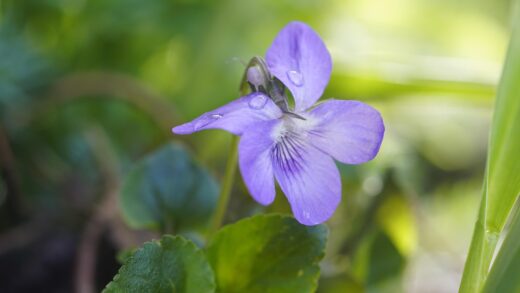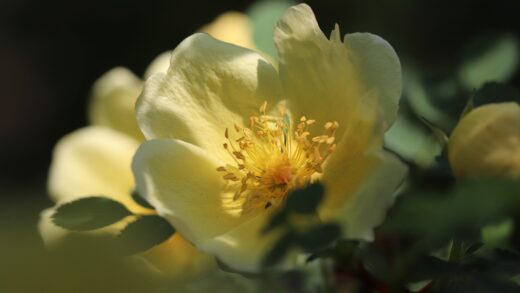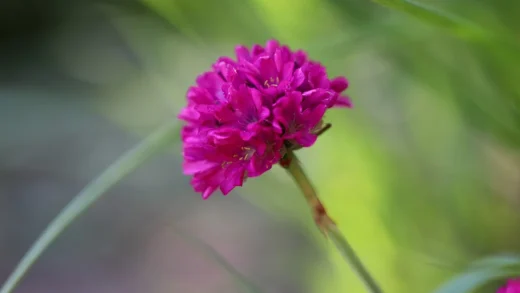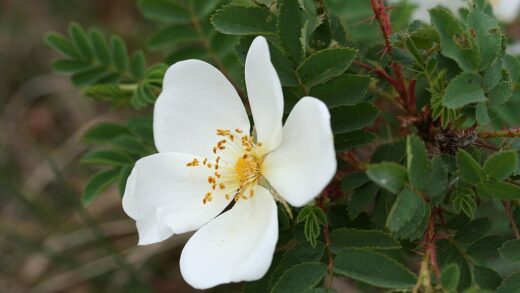The essence of dappled shade
The ideal light condition for English bluebells is best described as dappled shade, a term that beautifully captures the shifting, filtered sunlight found on a woodland floor. This is not the deep, dark shade found under evergreen conifers, nor is it the full, relentless sun of an open field. Instead, it is a gentle, moving light that filters through the branches of a deciduous tree canopy. This type of light provides the perfect balance: it is bright enough to fuel the vigorous growth and flowering in spring, yet it offers protection from the harsh, scorching sun of mid-summer. Replicating this specific quality of light is one of the most important factors in successfully cultivating these iconic plants.
The timing of this dappled shade is also a crucial element of their natural habitat. In early spring, before the overhead trees have leafed out, the bluebells receive a significant amount of direct sunlight. This period of higher light intensity is perfectly timed to coincide with their most active phase of growth. It provides the energy they need to push their leaves up through the soil, develop strong flower stems, and produce their spectacular floral display. This is their moment in the sun, a window of opportunity to gather as much energy as possible.
As spring progresses into summer, the leaves on the deciduous trees above unfurl, creating a dense canopy. This canopy casts the area into deeper shade, dramatically changing the light conditions on the ground. This transition happens just as the bluebells have finished flowering and their foliage begins to die back. The increased shade helps to keep the soil cool and moist as the bulbs enter their summer dormancy, protecting them from the heat and stress of the summer sun. This natural, seasonal shift in light intensity is a rhythm to which the English bluebell is perfectly attuned.
Therefore, when choosing a planting location in a garden, the goal is to find a spot that mimics this seasonal light pattern. A position under a mature apple tree, a silver birch, or a group of large shrubs is often ideal. The north or east-facing side of a building can also provide similar conditions, offering bright morning light followed by afternoon shade. Understanding that ‘shade’ for a bluebell does not mean darkness, but rather this dynamic, filtered light, is the first step towards providing them with the environment they need to truly flourish.
Ideal planting locations in the garden
Translating the concept of dappled woodland shade into a practical garden setting involves identifying specific microclimates within your space. The most classic and effective location for English bluebells is in a woodland garden or at the edge of a wooded area. Planting them in large, informal drifts beneath a canopy of deciduous trees like oaks, beeches, or maples will create a breathtakingly naturalistic scene in spring. The trees provide the essential seasonal light shift, and the annual fall of their leaves provides a natural mulch that enriches the soil and nourishes the bulbs.
More articles on this topic
For those without a dedicated woodland area, planting bluebells amongst deciduous shrubs in a mixed border is an excellent alternative. Shrubs such as hydrangeas, viburnums, or dogwoods cast the same kind of filtered light. The bluebells will emerge and flower early in the season, often before the shrubs have fully leafed out, and their dying foliage will be conveniently hidden as the shrubs grow and fill in later in the season. This type of companion planting creates a layered, dynamic display that offers interest throughout the year.
The north or east-facing side of your house, a wall, or a fence can also provide the right light conditions. These locations typically receive gentle morning or ambient light but are shielded from the intense, direct sun of the afternoon. This protects the delicate flowers from fading too quickly and prevents the soil from drying out excessively. Planting a border along a shaded pathway or at the base of a north-facing wall can create a charming and beautiful feature, bringing colour and life to what might otherwise be a challenging, shady corner of the garden.
It is even possible to naturalize English bluebells in a lawn, provided the area is shaded by deciduous trees and you are willing to adjust your mowing schedule. The bluebells will flower in spring, and it is crucial that the grass is not cut until the bluebell foliage has completely died back, which is usually by early to mid-summer. This allows the bulbs to store enough energy for the following year. This approach can create a stunning and low-maintenance ‘meadow’ effect, transforming a simple patch of grass into a vibrant spring spectacle.
The consequences of too much sun
While English bluebells need a good amount of light in the spring, planting them in a location that receives full, direct sun for most of the day can be highly detrimental. The intense sunlight and associated heat can cause a number of problems. One of the most immediate effects is that the delicate, bell-shaped flowers will fade much more quickly, significantly shortening the blooming period. The deep violet-blue colour can appear washed-out and bleached in harsh sun, and the overall display will be far less impactful and long-lasting than in a shaded location.
More articles on this topic
Excessive sun exposure can also scorch the leaves. The foliage may develop yellow or brown patches, and the tips can become dry and crispy. This damage reduces the leaf’s surface area available for photosynthesis, which is the vital process through which the plant creates and stores energy in its bulb. If the leaves are damaged and die back prematurely due to sun scorch, the bulb will not be able to store sufficient reserves, leading to a weaker plant and poorer flowering in subsequent years. This can create a cycle of decline from which the colony may struggle to recover.
Furthermore, a sunny location will inevitably have warmer and drier soil than a shaded one. This is contrary to the cool, moist conditions that English bluebells require. The soil will dry out much more rapidly, placing the plants under water stress, which can lead to wilting and stunted growth. Even with regular watering, it can be difficult to maintain the consistent level of moisture that these plants need. During the summer dormancy period, the bulbs can become baked in the hot, dry soil, which can lead to desiccation and a reduction in their viability.
In essence, planting English bluebells in full sun forces them to grow in an environment to which they are not adapted. While they may survive for a season or two, especially if the bulbs were large and healthy when planted, they will almost certainly decline over time. The stress of the excessive light, heat, and dryness will weaken the plants, making them more susceptible to pests and diseases and leading to a gradual disappearance from the garden. For long-term success, respecting their need for shade is not just a preference, but a necessity.
The challenges of too little light
Just as too much sun is harmful, too little light can also cause significant problems for English bluebells. While they are shade-tolerant plants, they are not suited to the deep, year-round shade that is often found under dense evergreen trees, such as conifers, or on the perpetually shaded side of a building that receives no direct light at all. In these conditions of very low light intensity, the plants will struggle to photosynthesize effectively, which has a direct impact on their growth and ability to flower.
The most common symptom of insufficient light is a lack of flowers. The plants may produce leaves, but they will often be a pale green colour and may appear elongated and spindly as they stretch in a desperate search for more light. This phenomenon is known as etiolation. Without enough light energy to create surplus food reserves, the bulb will prioritize its own survival and the production of leaves over the energetically expensive process of creating flowers. An established colony that was once floriferous but has gradually stopped blooming may be suffering from an increase in shade as overhead trees have matured and their canopy has become denser.
Even if the plants do manage to produce some flowers in very shady conditions, the display will likely be sparse and the flower stalks weak and floppy. The plants will lack the robust, vigorous appearance of those grown in more ideal, brighter shade. This overall lack of vigour also makes the plants more vulnerable to pests and diseases. They simply do not have the energy reserves to defend themselves effectively or to recover from any damage that occurs.
If you suspect that your bluebells are suffering from too little light, there are a few remedial actions you can take. For plants growing under deciduous trees, you could consider carefully pruning some of the lower branches or thinning the canopy to allow more filtered light to reach the ground. This can make a significant difference. If the bluebells are in a permanently deep-shaded border, the only viable solution is to lift the bulbs during their dormant season and move them to a more suitable location in the garden that offers the bright, dappled light they need to thrive and produce their glorious spring display.


















